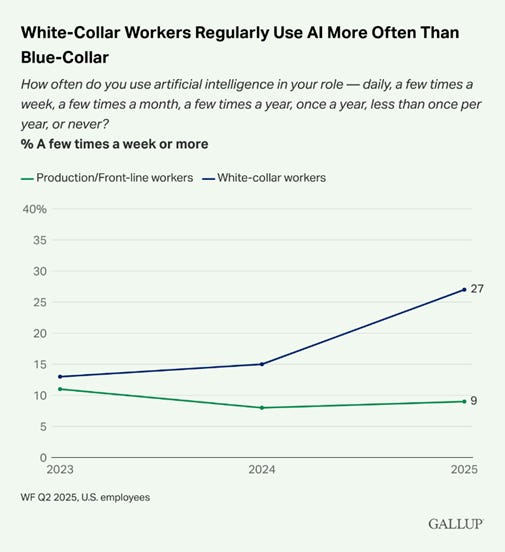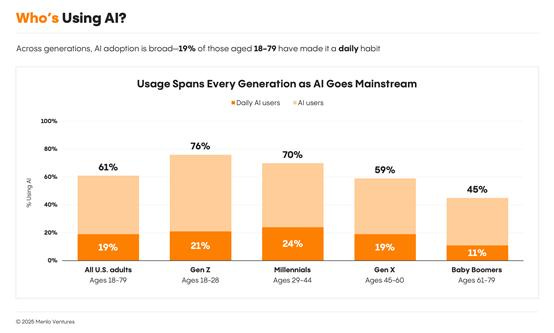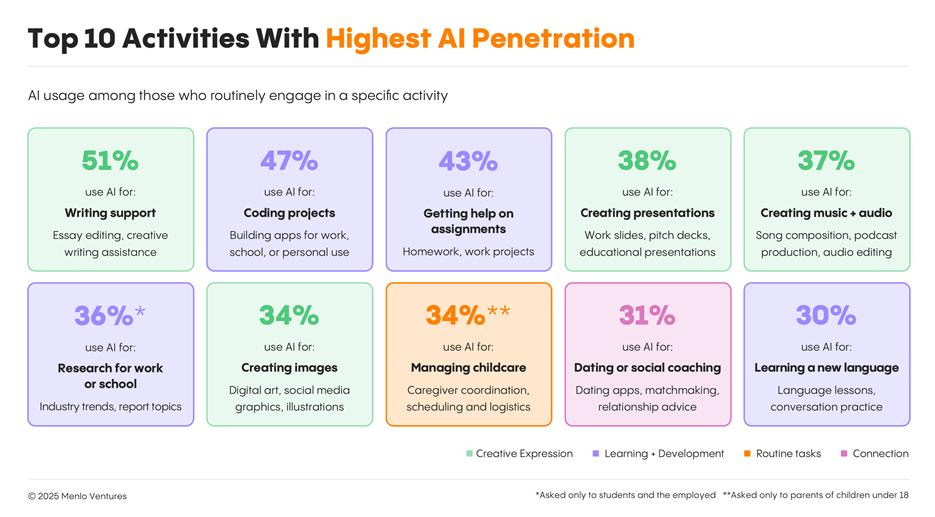AI Adoption Hits a Tipping Point
Reports show AI usage is rapidly rising in the workplace and at home, with more to come. Companies and consumers can and should lean in on AI adoption to make the best use of AI.
Introduction
AI usage is surging. In our latest AI Week in Review, we mentioned the Gallup survey on AI usage that showed a doubling of AI usage in the past two years, with 27% of white-collar workers now using AI several times a week or more.
Two recent reports confirm this rapid increase in AI usage in the workplace and in our daily lives. One is the AI at Work report by Boston Consulting Group, which includes as slideshow headlined “Momentum Builds, But Gaps Remain.” The surveyed global employees about the use of AI in the workplace.
The other report, from the VC firm Menlo Ventures, covers consumer of AI and is called “2025: The State of Consumer AI.” Their key takeaway is that “AI’s Consumer Tipping Point Has Arrived.” According to their survey numbers, 61% of American adults have used AI in the past six months, and nearly one in five rely on it every day.
Although there are differences in total adoption numbers, the curves and trends are consistent and even expected. Rapid AI improvements are opening up new use cases and driving rapid AI adoption. We share further details and takeaways from these recent reports below.
AI Goes to Work
Boston Consulting Group’s AI at Work: Momentum Builds, but Gaps Remain is based on a survey of 10,000 employee respondents. It surveyed across industries and job roles from frontline employees to company leaders, and surveyed employees from many countries, with as many respondents from the UK, India and Brazil as the US.
Regular frequent AI use (defined as using AI at least several times a week) in the workplace by managers rose from 64% to 78% since 2024, but regular AI use by frontline employees is at 52% in 2025, barely above 2024 levels of 51%. Company leaders are high users of AI, with 88% using it.
A big caveat with these numbers: The BCG survey is sampling from global company employee respondents, which is not demographically representative. For example, survey respondents from India, the Middle East, and Spain, reported the highest regular use of AI – 92%, 87%, and 78% respectively – far higher than each country’s overall usage levels.
Comparing BCG numbers with the Gallup survey for US surveyed workers shows this difference as well. The BCG reported 64% of US respondents were frequent AI users. The Gallup survey shows that frequent AI (use AI a few times a week or more) use among leaders is at 33%; frequent AI use by white-collar workers is 27%; frequent AI use by front-line workers is 9%.
The Gallup survey shows significant increases in AI usage from 2024.

The BCG survey shows consistent positive trends among AI users:
Employees have improved views on AI, especially if they are users of AI: Confidence about AI is rising and concerns are falling.
AI usage saves users’ time: 47% of respondents say they save more than six hours a week with the use of AI.
The largest negative concern is that there is a fear of job loss due to AI, with over 41% of respondents saying they fear losing their job due to AI. The number is highest in the countries also reporting the highest AI adoption.

AI Leadership in the Workplace
Frontline employees have hit a “silicon ceiling,” with only half of them regularly using artificial intelligence tools, according to BCG’s third annual global AI at Work survey. Companies are realizing that merely introducing AI tools into existing ways of working isn’t enough to unlock their full potential. Real value is generated when businesses reshape their workflows end-to-end and promote use of the technology. – Boston Consulting Group
The other part of the BCG survey, as befits a management consulting firm, guides advice for management on AI adoption in the workplace. Their survey confirms the need for strong leadership support for AI adoption strategies, to improve positive employee engagement with AI:
The share of employees who feel positive about GenAI rises from 15% to 55% with strong leadership support.
While only 36% of respondents report that their AI training is enough, more AI training is driving higher AI adoption. Regular usage is sharply higher for employees that receive at least five hours of training and have access to in-person training and coaching.
Lack of support doesn’t stop AI use, however. When employees don’t have the AI tools they need, more than half (54%) said they will find alternatives and use them anyway, even if there are workplace restrictions.
Typical workplace adoption starts with adapting the new technology to existing workflows, then redesigning workflows to make the best use of the technology. The survey indicates that most are still in the initial stages of adoption. While 72% of respondents say their company is deploying generative AI tools, about half of respondents say their company is starting to reshape processes around AI.

Similarly, most companies are in pilot stages of AI agent adoption. While a majority of respondents in BCG’s survey say that AI agents are being used in pilots or under human supervision at their companies, only 13% say AI agents are being integrated into broader workflows.
BCG suggests these strategic imperatives for leadership in AI workplace adoption:
Commit appropriate levels of investment, time, and leadership support to AI and AI training.
Track the value AI brings in improving productivity, quality, and employee satisfaction.
Invest in people to reshape workflows and unlock AI’s value. Build upskilling and reskilling capabilities to support workforce deployment.
Experiment rigorously with AI agents to accelerate the experience curve. Track impact and potential risks via A/B testing.
The State of Consumer AI
The Menlo Ventures report The State of Consumer AI reaffirms the massive increase in AI usage in the past two years, noting that their survey shows 61% of Americans have used AI in the last 6 months, while 19% are now daily users.
Despite massive AI adoption, the current $12 billion market for AI suggests only 3% actually pay for AI tools. (Note, this is consumer only, the enterprise AI market was almost $14 billion in 2024.) The vast majority of consumers use free versions of AI. They call it:
a strikingly low conversion rate and one of the largest and fastest-emerging monetization gaps in recent consumer tech history.
Their report covers not just aggregate usage numbers, but where, why and how consumers are using AI. It presents many interesting findings.

Consumer AI usage spans a wide range of activities, from mundane tasks to more critical areas like health and education. The most common usage is for routine tasks: Drafting emails, planning meals, researching purchases, and organizing notes and to-do lists.
Learning and education needs drive AI use. Students’ usage of AI is the highest of any demographic, with 85% of students (18 and older) reporting using AI. More surprisingly, parents are also a high usage demographic, leveraging AI to manage their daily routines and support their children’s education. Parental usage rises as children grow older.
The activities with the highest AI penetration give a glimpse of those specific tasks AI is most suited for. Most of the top AI tasks are familiar: Writing support, coding projects, creating presentations, research tasks for work or school, getting help on assignments or work projects, and creating images.

The AI tool market to support these tasks is currently dominated by general-purpose AI assistants, and consumers tend to use only one AI assistant as their default:
91% of AI users reach for their favorite general AI tool for nearly every job.
This tends to favor the original AI assistant ChatGPT, with 28% of U.S. adults using it. OpenAI’s first-mover gives them an advantage on revenue, earning them about 70% of total consumer spending on AI.

While general AI assistants are dominating for now, there is an opportunity for specialized AI tools that outperform general AI platforms in specific domains. The greatest opportunities for specialized AI tools lie in high-trust domains where AI reliability and trust isn’t yet sufficient. Health-related tasks have lower AI penetration because of these factors.
Conclusion - AI Adoption Trends and Opportunities
Today’s AI handles discrete tasks like drafting text or generating images. The next generation will run complex workflows from end to end. – Menlo Ventures
In the past year, AI reasoning models and AI integration features that leverage tools and web search have unlocked ‘next level’ capabilities in AI systems. These capabilities have taken AI from GPT-4-level AI chatbots to highly capable AI agents, which has enabled deeply useful AI tools for research, coding, customer support, brainstorming, and a lot more.
As AI becomes more useful, AI adoption is surging both in the workplace and at home, taking on more tasks and doing them better than before.
Workplace AI usage increased in 2025 from 2024, with higher use among white-collar workers, company managers and leaders, and younger employees. Many AI users report that AI is already saving them many hours of time per week by automating some tasks. AI is evolving from novelty and toy to productive assistant for routine tasks.
AI is transforming workplaces in leading companies, but gaps in frontline adoption, training, and integration remain. Most companies are in the early phases of AI adoption, deploying AI to support current workflows but not implementing workflow redesigns. Companies investing in leadership support, AI training, and workflow redesign are best positioned to harness AI's potential.
U.S. consumers are increasingly using AI across a range of tasks, including routine, educational, and creative tasks. With only 3% paying for AI, the consumer AI market has room to grow. We will see both general and specialized AI applications, catering to a diverse and growing user base.
We are still in the early innings of the AI revolution, so no matter where you are on AI adoption curve, whether neophyte or power user, you can learn to use AI more productively. Early AI adopters gained much from learning and productively using AI, but anyone can quickly access the latest AI models and reap those same benefits. As you learn AI, use the AI model itself to guild you; your AI assistant is a fine tutor.




